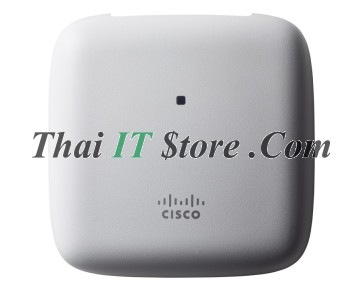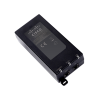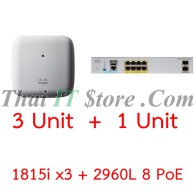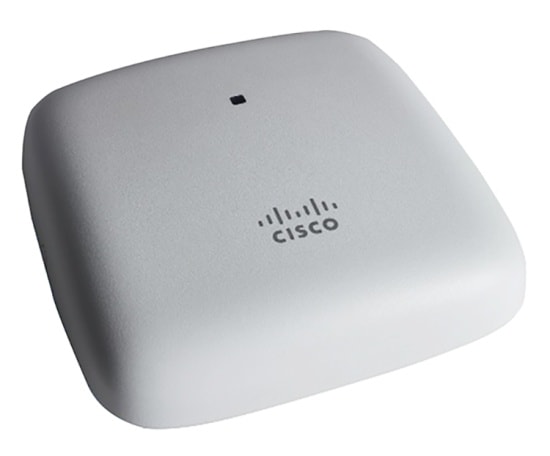- หน้าหลัก
- Wireless (แอ็กเซสพอยต์)
- Cisco Aironet 1815 | AIR-AP1815I-S-K9 Aironet 1815i Lightweight AP Internal Antenna


มีบริการอุปกรณ์สำรองระหว่างซ่อมและ Onsite Services ตลอด 24 ชั่วโมง 365 วัน (ข้อมูลเพิ่มเติม คลิก...)
Cisco Aironet 1815 | AIR-AP1815I-S-K9 Aironet 1815i Lightweight AP Internal Antenna
| Band: | Cisco |
| Type: | Wireless Access Point |
| Model: | Aironet 1815 |
| Part Number: | AIR-AP1815I-S-K9 |
| Features: | Lightweight AP |
| Detail: | AIR-AP1815I-S-K9 | Aironet 1815i Lightweight AP Internal Antenna Special Promotion ซื้อ 2 แถม 1 |
เลือกสินค้าที่ต้องการหยิบใส่รถเข็น หรือ เลือกทั้งหมด
บทความที่เกี่ยวข้อง
- Cisco MA แบบ SMB Support (CON-SMBS) คืออะไร
- Engineer Services
- Pre-Sale Services
- ตั้งค่า COM port เพื่อ Config Cisco
- เครื่องคอมใช้ COM port อะไรตั้งค่า Cisco
- ตั้งค่า Cisco Console (Serial port) สำหรับ Config ด้วย Putty
- วิธี Download Cisco Firmware, IOS
- ติดตั้ง และตั้งค่า TFTP Server สำหรับ Cisco
- การรับประกัน
- การจัดส่ง
- การชำระเงิน
- ขั้นตอนขอเปลี่ยนอุปกรณ์ เพื่อทดแทนอุปกรณ์ที่เสีย (Hardware Replacement)
- ขั้นตอนการสมัคร CCO id
- Cisco SMARTnet vs SMBS
- Cisco DOA Warranty 90 วัน คืออะไร
Ideal for small and medium-sized networks, the Cisco® Aironet® 1815i Access Point brings a full slate of Cisco high-performance functionality to the enterprise environment.
Product overview
The Cisco Aironet 1815i delivers industry-leading wireless performance with support for the latest Wi-Fi standard, IEEE’s 802.11ac Wave 2 (Figure 1). It also meets the growing requirements of wireless networks by delivering a better user experience.
The 1815i extends support to a new generation of Wi-Fi clients, such as smartphones, tablets, and high-performance laptops that have integrated 802.11ac Wave 1 or Wave 2 support.
Cisco Aironet 1815i Access Point
Features and benefits
By adhering to the 802.11ac Wave 2 standard, the 1815i offers a data rate of up to 867 Mbps on the 5-GHz radio. This exceeds the data rates offered by access points that support the 802.11n standard. It also enables a total aggregate dual-radio data rate of up to 1 Gbps. This provides the necessary foundation for enterprise and service provider networks to stay ahead of the performance expectations and needs of their wireless users.
Due to its convenience, in recent years corporate users have increasingly preferred wireless access as the form of network connectivity. Along with this shift, there is an expectation that wireless should not slow down users’ day-to-day work, but should enable a high-performance experience while allowing users to move freely. The 1815i delivers industry-leading performance for highly secure and reliable wireless connections and provides a robust mobility end-user experience. Table 1 lists the features and benefits of the 1815i.
Features and benefits
|
Feature |
Benefit |
|
MU-MIMO |
Multiuser (MU) multiple-input multiple-output (MU-MIMO) allows transmission of data to multiple 802.11ac Wave 2–capable clients simultaneously to improve the client experience. Prior to MU-MIMO, 802.11n and 802.11ac Wave 1 access points could transmit data to only one client at a time, typically referred to as single-user MIMO (SU‑MIMO). 802.11ac Wave 2 with 2x2:2 MIMO technology uses two spatial streams when operating in SU-MIMO or MU-MIMO mode, offering 867-Mbps rates for more capacity and reliability than competing access points. |
|
Cisco Mobility Express solution |
Flexible deployment through the Mobility Express solution is ideal for small to medium-sized deployments. Easy setup allows the 1815i to be deployed on networks without a physical controller. |
|
Integrated Bluetooth 4.1 |
Integrated Bluetooth low-energy (BLE) 4.1 radio for location and asset tracking (future availability). |
Prominent features
Increased wireless performance
The 1815i access point supports the latest 802.11ac Wave 2 standard for higher performance, greater access, and higher-density networks. With simultaneous dual radios and dual band with 802.11ac Wave 2 MU-MIMO functionality, this access point can handle the increasing number of high-bandwidth devices that will soon become a common part of the network.
Wired access
The 1815i allows wired access via a single RJ-45 10/100/1000 auto-detection port. It supports full operation modes using PoE 802.3af power.
Mounting
These sleek access points with a small form factor are designed with flexible mounting options in mind. You can mount them directly on the ceiling or a wall. They are also easy to install.
Product specifications
Table lists the specifications for the Cisco Aironet 1815i Access Point. Table 3 provides the access point’s RF specifications.
Specifications
|
Item |
Specification |
|||||||
|
Authentication and security |
● Advanced Encryption Standard (AES) for Wi-Fi Protected Access 3 (WPA3), WPA2, WPA ● 802.1X, RADIUS authentication, authorization, and accounting (AAA) ● 802.11r ● 802.11i | |||||||
|
Software |
● Cisco Unified Wireless Network Software with AireOS Wireless Controllers Release 8.5 or later ● Cisco Mobility Express | |||||||
|
Supported WLAN Controllers |
● Cisco 2500 Series Wireless Controllers, Cisco 3500 Series Wireless Controllers, Cisco Wireless Controller Module for ISR G2, Cisco Wireless Services Module 2 (WiSM2) for Catalyst® 6500 Series Switches, Cisco 5500 Series Wireless Controllers, Cisco Flex® 7500 Series Wireless Controllers, Cisco 8500 Series Wireless Controllers, Cisco 9800 series Wireless Controllers, ● Cisco Mobility Express | |||||||
|
Maximum clients |
● Maximum number of associated wireless clients: 200 per Wi-Fi radio, in total 400 clients per access point | |||||||
|
802.11ac |
● 2x2 single-user/multiuser MIMO with two spatial streams ● Maximal ratio combining (MRC) ● 20-, 40- and 80-MHz channels ● PHY data rates up to 866.7 Mbps (80 MHz on 5 GHz) ● Packet aggregation: A-MPDU (Tx/Rx), A-MSDU (Rx) ● 802.11 Dynamic Frequency Selection (DFS) ● Cyclic shift diversity (CSD) support | |||||||
|
Ethernet ports |
● Authentication with 802.1X or MAC filtered ● Dynamic VLAN or per port ● Traffic locally switched or tunneled back to wireless LAN controller | |||||||
|
Bluetooth (future availability) |
● Integrated Bluetooth 4.1 (including BLE) radio ● Maximum transmit power: 4 dBm ● Antenna gain: 2 dBi | |||||||
|
Data rates supported |
802.11a: 6, 9, 12, 18, 24, 36, 48, 54 Mbps |
|||||||
|
802.11b/g: 1, 2, 5.5, 6, 9, 11, 12, 18, 24, 36, 48, 54 Mbps |
||||||||
|
802.11n data rates on 2.4 GHz: |
||||||||
|
MCS Index1 |
GI2 = 800 ns |
GI = 400 ns |
||||||
|
20-MHz Rate (Mbps) |
20-MHz Rate (Mbps) |
|||||||
|
0 |
6.5 |
7.2 |
||||||
|
1 |
13 |
14.4 |
||||||
|
2 |
19.5 |
21.7 |
||||||
|
3 |
26 |
28.9 |
||||||
|
4 |
39 |
43.3 |
||||||
|
5 |
52 |
57.8 |
||||||
|
6 |
58.5 |
65 |
||||||
|
7 |
65 |
72.2 |
||||||
|
8 |
13 |
14.4 |
||||||
|
9 |
26 |
28.9 |
||||||
|
10 |
39 |
43.3 |
||||||
|
11 |
52 |
57.8 |
||||||
|
12 |
78 |
86.7 |
||||||
|
13 |
104 |
115.6 |
||||||
|
14 |
117 |
130 |
||||||
|
15 |
130 |
144.4 |
||||||
|
|
802.11ac data rates on 5 GHz: |
|||||||
|
MCS Index |
Spatial Streams |
GI = 800 ns |
GI = 400 ns |
|||||
|
|
|
20-MHz Rate (Mbps) |
40-MHz Rate (Mbps) |
80-MHz Rate (Mbps) |
20-MHz Rate (Mbps) |
40-MHz Rate (Mbps) |
80-MHz Rate (Mbps) |
|
|
0 |
1 |
6.5 |
13.5 |
29.3 |
7.2 |
15 |
32.5 |
|
|
1 |
1 |
13 |
27 |
58.5 |
14.4 |
30 |
65 |
|
|
2 |
1 |
19.5 |
40.5 |
87.8 |
21.7 |
45 |
97.5 |
|
|
3 |
1 |
26 |
54 |
117 |
28.9 |
60 |
130 |
|
|
4 |
1 |
39 |
81 |
175.5 |
43.3 |
90 |
195 |
|
|
5 |
1 |
52 |
108 |
234 |
57.8 |
120 |
260 |
|
|
6 |
1 |
58.5 |
121.5 |
263.3 |
65 |
135 |
292.5 |
|
|
7 |
1 |
65 |
135 |
292.5 |
72.2 |
150 |
325 |
|
|
8 |
1 |
78 |
162 |
351 |
86.7 |
180 |
390 |
|
|
9 |
1 |
– |
180 |
390 |
– |
200 |
433.3 |
|
|
0 |
2 |
13 |
27 |
58.5 |
14.4 |
30 |
65 |
|
|
1 |
2 |
26 |
54 |
117 |
28.9 |
60 |
130 |
|
|
2 |
2 |
39 |
81 |
175.5 |
43.3 |
90 |
195 |
|
|
3 |
2 |
52 |
108 |
234 |
57.8 |
120 |
260 |
|
|
4 |
2 |
78 |
162 |
351 |
86.7 |
180 |
390 |
|
|
5 |
2 |
104 |
216 |
468 |
115.6 |
240 |
520 |
|
|
6 |
2 |
117 |
243 |
526.5 |
130 |
270 |
585 |
|
|
7 |
2 |
130 |
270 |
585 |
144.4 |
300 |
650 |
|
|
8 |
2 |
156 |
324 |
702 |
173.3 |
360 |
780 |
|
|
9 |
2 |
– |
360 |
780 |
– |
400 |
866.7 |
|
|
Maximum number of non-overlapping channels |
A (A regulatory domain): ● 2.412 to 2.462 GHz; 11 channels ● 5.180 to 5.320 GHz; 8 channels ● 5.500 to 5.700 GHz; 8 channels(excludes 5.600 to 5.640 GHz) ● 5.745 to 5.825 GHz; 5 channels B (B regulatory domain): ● 2.412 to 2.462 GHz; 11 channels ● 5.180 to 5.320 GHz; 8 channels ● 5.500 to 5.720 GHz; 12 channels ● 5.745 to 5.825 GHz; 5 channelsC (C regulatory domain): ● 2.412 to 2.472 GHz; 13 channels ● 5.745 to 5.825 GHz; 5 channelsD (D regulatory domain): ● 2.412 to 2.462 GHz; 11 channels ● 5.180 to 5.320 GHz; 8 channels ● 5.745 to 5.825 GHz; 5 channelsE (E regulatory domain): ● 2.412 to 2.472 GHz; 13 channels ● 5.180 to 5.320 GHz; 8 channels ● 5.500 to 5.700 GHz; 8 channels(excludes 5.600 to 5.640 GHz) F (F regulatory domain): ● 2.412 to 2.472 GHz; 13 channels ● 5.250 to 5.350 GHz; 4 channels ● 5.725 to 5.825 GHz; 4 channelsG (G regulatory domain): ● 2.412 to 2.472 GHz; 13 channels ● 5.745 to 5.865 GHz; 7 channelsH (H regulatory domain): ● 2.412 to 2.472 GHz; 13 channels ● 5.180 to 5.320 GHz; 8 channels ● 5.745 to 5.825 GHz; 5 channelsI (I regulatory domain): ● 2.412 to 2.472 GHz; 13 channels ● 5.180 to 5.320 GHz; 8 channels |
K (K regulatory domain): ● 2.412 to 2.472 GHz; 13 channels ● 5.180 to 5.320 GHz; 8 channels ● 5.500 to 5.620 GHz; 7 channels ● 5.745 to 5.805 GHz; 4 channelsN (N regulatory domain): ● 2.412 to 2.462 GHz; 11 channels ● 5.180 to 5.320 GHz; 8 channels ● 5.745 to 5.825 GHz; 5 channelsQ (Q regulatory domain): ● 2.412 to 2.472 GHz; 13 channels ● 5.180 to 5.320 GHz; 8 channels ● 5.500 to 5.700 GHz; 11 channelsR (R regulatory domain): ● 2.412 to 2.472 GHz; 13 channels ● 5.180 to 5.320 GHz; 8 channels ● 5.660 to 5.700 GHz; 3 channels ● 5.745 to 5.805 GHz; 4 channelsS (S regulatory domain): ● 2.412 to 2.472 GHz; 13 channels ● 5.180 to 5.320 GHz; 8 channels ● 5.500 to 5.700 GHz; 11 channels ● 5.745 to 5.825 GHz; 5 channelsT (T regulatory domain): ● 2.412 to 2.462 GHz; 11 channels ● 5.280 to 5.320 GHz; 3 channels ● 5.500 to 5.700 GHz; 8 channels(excludes 5.600 to 5.640 GHz) ● 5.745 to 5.825 GHz; 5 channels Z (Z regulatory domain): ● 2.412 to 2.462 GHz; 11 channels ● 5.180 to 5.320 GHz; 8 channels ● 5.500 to 5.700 GHz; 8 channels(excludes 5.600 to 5.640 GHz) ● 5.745 to 5.825 GHz; 5 channels |
||||||
|
Note: This varies by regulatory domain. Refer to the product documentation for specific details for each regulatory domain. |
||||||||
|
Available transmit power settings |
2.4 GHz 20 dBm (100 mW) 17 dBm (50 mW) 14 dBm (25 mW) 11 dBm (12.5 mW) 8 dBm (6.25 mW) 5 dBm (3.13 mW) 2 dBm (1.56 mW) -1 dBm (0.78 mW) |
5 GHz 20 dBm (100 mW) 17 dBm (50 mW) 14 dBm (25 mW) 11 dBm (12.5 mW) 8 dBm (6.25 mW) 5 dBm (3.13 mW) 2 dBm (1.56 mW) -1 dBm (0.78mW) |
||||||
|
Note: The maximum power setting will vary by channel and according to individual country regulations. Refer to the product documentation for specific details. |
||||||||
|
Integrated antennas |
● 2.4 GHz, gain 2 dBi ● 5 GHz, gain 4 dBi | |||||||
|
Interfaces |
● 1 x 10/100/1000BASE-T autosensing (RJ-45), Power over Ethernet (PoE) ● Management console port (RJ-45) | |||||||
|
Indicators |
● Status LED indicates boot loader status, association status, operating status, boot loader warnings, boot loader errors | |||||||
|
Dimensions (W x L x H) |
● Access point (without mounting bracket): 6 x 6 x 1.3 in (150.8 x 150.8 x 33 mm) | |||||||
|
Weight |
● Access point without mounting bracket or any other accessories: 14 oz (400 g) | |||||||
|
Environmental |
● Operating
◦ Temperature: 32° to 104°F (0° to 40°C)
◦ Humidity: 10% to 90% (noncondensing)
◦ Max. altitude: 9843 ft (3000 m) @ 40°C
● Nonoperating (storage and transportation)
◦ Temperature: -22° to 158°F (-30° to 70°C)
◦ Humidity: 10% to 90% (noncondensing)
◦ Max. altitude: 15,000 ft (4500 m) @ 25°C
|
|||||||
|
System |
● 1 GB DRAM ● 256 MB flash ● 710 MHz quad core | |||||||
|
Input power requirements |
● Power injector: AIR-PWRINJ5= or AIR-PWRINJ6= | |||||||
|
Powering options |
● 802.3af/at Ethernet switch ● Optional Cisco power injectors (AIR-PWRINJ5=, AIR-PWRINJ6=) | |||||||
|
Power draw |
● 8.3W (maximum, on PoE) | |||||||
|
Physical security |
● Torx security screw, included with the access point | |||||||
|
Mounting |
● Included with the access point: mounting bracket AIR-AP-BRACKET8 | |||||||
|
Accessories |
● Mounting bracket: AIR-AP-BRACKET8= (available as spare) ● Physical security kit: AIR-SEC-50= (sold separately), with 50 pcs. Security screws used to secure access point onto wall-mounting bracket, 50 pcs. RJ-45 caps and 2 pcs. unlock keys used to block physical access to Ethernet ports | |||||||
|
Warranty |
Limited Lifetime Hardware Warranty |
|||||||
|
Compliance |
● Safety:
◦ UL 60950-1
◦ CAN/CSA-C22.2 No. 60950-1
◦ UL 2043
◦ IEC 60950-1
◦ EN 60950-1
● Radio approvals:
◦ FCC Part 15.247, 15.407
◦ RSS-247 (Canada)
◦ EN 300.328, EN 301.893 (Europe)
◦ ARIB-STD 66 (Japan)
◦ ARIB-STD T71 (Japan)
◦ EMI and susceptibility (Class B)
◦ FCC Part 15.107 and 15.109
◦ ICES-003 (Canada)
◦ VCCI (Japan)
◦ EN 301.489-1 and -17 (Europe)
◦ EN 50385
● IEEE standards:
◦ IEEE 802.11a/b/g, 802.11n, 802.11h, 802.11d
◦ IEEE 802.11ac
● Security:
◦ 802.11i, WPA3, WPA2, WPA
◦ 802.1X
◦ AES
● Extensible Authentication Protocol (EAP) types:
◦ EAP-Transport Layer Security (TLS)
◦ EAP-Tunneled TLS (TTLS) or Microsoft Challenge Handshake Authentication Protocol Version 2 (MSCHAPv2)
◦ Protected EAP (PEAP) v0 or EAP-MSCHAPv2
◦ EAP-Flexible Authentication via Secure Tunneling (FAST)
◦ PEAP v1 or EAP-Generic Token Card (GTC)
◦ EAP-Subscriber Identity Module (SIM)
● Multimedia:
◦ Wi-Fi Multimedia (WMM)
● Other:
◦ FCC Bulletin OET-65C
◦ RSS-102
|
|||||||
RF Specifications
|
Transmit power and receive sensitivity (1815i) |
|||||
|
|
|
2.4-GHz Radio |
5-GHz Radio |
||
|
|
Spatial Streams |
Total TX Power (dBm) |
RX Sensitivity (dBm) |
Total TX Power (dBm) |
RX Sensitivity (dBm) |
|
802.11/11b |
|||||
|
1 Mbps |
1 |
17 |
-98 |
NA |
NA |
|
11 Mbps |
1 |
17 |
-89 |
NA |
NA |
|
802.11a/g |
|||||
|
6 Mbps |
1 |
20 |
-94 |
17 |
-94 |
|
24 Mbps |
1 |
20 |
-87 |
20 |
-87 |
|
54 Mbps |
1 |
20 |
-78 |
18 |
-78 |
|
802.11n HT20 |
|||||
|
MSC0 |
1 |
20 |
-93 |
20 |
-93 |
|
MSC4 |
1 |
20 |
-83 |
18 |
-82 |
|
MSC7 |
1 |
20 |
-75 |
16 |
-75 |
|
MSC8 |
2 |
20 |
-90 |
20 |
-90 |
|
MSC12 |
2 |
20 |
-80 |
18 |
-79 |
|
MSC15 |
2 |
20 |
-72 |
16 |
-72 |
|
802.11n HT40 |
|||||
|
MSC0 |
1 |
|
|
20 |
-90 |
|
MSC4 |
1 |
|
|
18 |
-79 |
|
MSC7 |
1 |
|
|
16 |
-72 |
|
MSC8 |
2 |
|
|
20 |
-87 |
|
MSC12 |
2 |
|
|
18 |
-76 |
|
MSC15 |
2 |
|
|
16 |
-69 |
|
802.11ac VHT20 |
|||||
|
MSC0 |
1 |
|
|
20 |
-93 |
|
MSC4 |
1 |
|
|
18 |
-82 |
|
MSC7 |
1 |
|
|
16 |
-75 |
|
MSC8 |
1 |
|
|
15 |
-71 |
|
MSC0 |
2 |
|
|
20 |
-90 |
|
MSC4 |
2 |
|
|
18 |
-79 |
|
MSC7 |
2 |
|
|
16 |
-72 |
|
MSC8 |
2 |
|
|
15 |
-68 |
|
802.11ac VHT40 |
|||||
|
MSC0 |
1 |
|
|
20 |
-90 |
|
MSC4 |
1 |
|
|
18 |
-79 |
|
MSC7 |
1 |
|
|
16 |
-72 |
|
MSC8 |
1 |
|
|
15 |
-68 |
|
MSC9 |
1 |
|
|
15 |
-66 |
|
MSC0 |
2 |
|
|
20 |
-87 |
|
MSC4 |
2 |
|
|
18 |
-76 |
|
MSC7 |
2 |
|
|
16 |
-69 |
|
MSC8 |
2 |
|
|
15 |
-65 |
|
MSC9 |
2 |
|
|
15 |
-63 |
|
802.11ac VHT80 |
|||||
|
MSC0 |
1 |
|
|
20 |
-87 |
|
MSC4 |
1 |
|
|
18 |
-77 |
|
MSC7 |
1 |
|
|
16 |
-69 |
|
MSC8 |
1 |
|
|
15 |
-65 |
|
MSC9 |
1 |
|
|
15 |
-63 |
|
MSC0 |
2 |
|
|
20 |
-84 |
|
MSC4 |
2 |
|
|
18 |
-74 |
|
MSC7 |
2 |
|
|
16 |
-66 |
|
MSC8 |
2 |
|
|
15 |
-62 |
|
MSC9 |
2 |
|
|
15 |
-60 |
|
Note: The maximum power setting will vary by channel and according to individual country regulations. Refer to the product documentation for specific details. |
|||||
Ordering information
Table provides ordering information for the Cisco Aironet 1815i Access Point.
Ordering information
|
Product Name |
Part Number |
|
Cisco Aironet 1815i |
● AIR-AP1815i-x-K9: Dual-band, controller-based 802.11a/g/n/ac, Wave 2
● AIR-AP1815i-x-K9C: Dual-band 802.11a/g/n/ac Wave 2 with default software Mobility Express
◦ Regulatory domains: (x = regulatory domain)
◦ For Mobility Express, part number AIR-AP1815i-x-K9C offers default software option Mobility Express
Customers are responsible for verifying approval for use in their individual countries. To verify approval that corresponds to a particular country or the regulatory domain used in a specific country Not all regulatory domains have been approved. As they are approved, the part numbers will be available on the Global Price List. |
Cisco Wireless LAN Services
Realize the full business value of your technology investments faster with intelligent, customized services from Cisco. Backed by deep networking expertise, Cisco Wireless LAN Services enable you to deploy a sound, scalable mobility network that enables rich media collaboration while improving the operational efficiency gained from a converged wired and wireless network infrastructure based on the Cisco Unified Wireless Network. We offer expert advisory, implementation and optimization services to accelerate your transition to advanced mobility services while continuously optimizing the performance, reliability, and security of that architecture after it is deployed. In addition, Smart Net Total Care service helps you protect your investment and derive maximum value from your Cisco products. Delivered by Cisco and backed by your trusted partner, this comprehensive service includes access to the Cisco Technical Assistance Center 24 hours a day, 365 days a year, IOS software updates, online resources, and expedited hardware replacement when needed. The Smart Net Total Care service helps you solve problems faster, improve operational efficiency, and reduce the risk of downtime. For more details, visit: https://www.cisco.com/c/en/us/products/wireless/service-listing.html.
Cisco Wireless LAN Services
● AS-WLAN-CNSLT: Cisco Wireless LAN Network Planning and Design Service
● AS-WLAN-CNSLT: Cisco Wireless LAN 802.11n Migration Service
● AS-WLAN-CNSLT: Cisco Wireless LAN Performance and Security Assessment Service
Warranty information
The Cisco Aironet 1815i Access Point comes with a Limited Lifetime Warranty that provides full warranty coverage of the hardware for as long as the original end user continues to own or use the product. The warranty includes 10‑day advance hardware replacement and ensures that software media is defect-free for 90 days.
| ประเภท | Wireless Access Point |
|---|---|
| Model | Aironet 1815 |
| License / Features | Lightweight AP |









